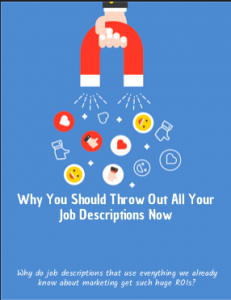Workshops People Remember, New Skills They Apply
Latest Workshops
Why Hire for Candidate Capacity for Flow, Meaning, and Working on Teams

Our most successful clients are optimizing hiring, evaluation, and recognition for each candidate’s around the Flow state.
In Flow, humans are several times more productive, more creative, and more likely to stay longer in the organization that helps them get there. It ain’t easy to optimize for Flow. That’s how you know it can’t really mean tossing keywords into a search engine.
If you’re not optimizing recruiting and talent management for Flow, you’re bleeding productivity, innovation, and employees. Getting most employees in Flow should be every organization’s primary directive. We'll show you how.
Story, or How to Start Hiring for What Matters Most: Flow, Meaning, Teamwork

Optimizing for Flow means selecting for a candidate’s capacity (1) to use her core strengths in the role and (2) to sustainably find meaning in it. High engagement at work looks exactly like Flow.
Flow is the River that Powers the Economy. We'll train your team in how to conduct behavior-based interviews that probe candidates' strengths, how they derive meaning from work and play, and whether they can find meaning in the roles for which they're interviewing.
Story, Meaning, and a Strong Employer Brand

Most organizations have little or no positive reputation because they simply haven’t learned to tell stories - the most powerful form of persuasion in the universe - about themselves. Not in the greater universe of the Employer Brand and especially not in the Job Description.
But it’s Story, or meaning, that fuels teams, lights up employee performance, and extends retention. An organization's stories are also what IPOs are built on, and they can make a difference of billions in valuation.
Reinvent Your Job Descriptions: Why and How

No one has training in how to write a job description or conduct an interview. We inevitably make up rules of thumb on the fly. But most aren't backed by science, and most of them will actually reduce diversity and role-candidate fit.
Our Role Opportunity Pitch isn’t a “description” of a job’s tasks but an argument for the life and career change opportunity that any job really is. It’s not hard to do, once you learn, and it’s an easy win because almost nobody else is offering a different, much less enhanced, vision of the job description!
You’ll learn how to create your own Role Opportunity Pitches to be more differentiating and informative about what candidates actually care about:
- Meaning and purpose
- Opportunities for learning, mentoring, and development
- Possible career paths
- A great boss (who practices sound management science)
- Autonomy
- Mastery
BONUS: How to make a video of the team and boss that joins the power of Story to real, passionate, and engaged employees.
Teams: How to Build High-Performance Teams Through Science

You can’t build great teams by hiring for a candidate’s individual accomplishments, like universities attended and GPAs. These factors have no correlation with team effectiveness. You need a reliable system to find people who can best contribute to their teams.
Based on the very latest evidence and best practices, we’ll show you how to build cultures of high-performance teams by recruiting and rewarding traits proven by science: team members’ capacity
- to contribute to the team a sense of meaning and impact
- to provide clarity and structure
- and above all, to enable others the psychological safety to question, experiment, and fail.
Teams: Psychological Safety Just Means Love - and Your Teams Need More of It

In this workshop we drill down with teams on the #1 factor in high-performance teams: team members' feelings of psychological safety. The results speak for themselves: more innovation and experimentation, less criticism, fear, and holding back; and longer tenures.
Managers: How to Select the Most Crucial Roles in Your Company

Managers are the #1 cause of employee engagement or employee departure. It's a special piece of madness that we choose managers based on their tenure or whether they did well in the job below.
It’s like not knowing difference between a king and a soldier. Few leaders are the best at what everyone on the team does, or always the smartest person in the room, though if you’ve been around the block, you’e seen people try.
Drawing on substantial new research from Gallup, Google, McKinsey, Glassdoor, and others, this workshop will teach you evidence-based methods for hiring great managers.
Turn Cognitive Errors and Unconscious Biases into Better Hiring Decisions
Companies whose teams have training about decision bias such as cognitive error and implicit bias are able to build better systems to reduce decision errors.
This workshop teaches employees about the cognitive error in all of us, shows them ways to forgive it and learn from it, and gives them crucial awareness to reduce bias in decision making.
Awareness:
- How Human Empathy is Selective, and Seeks Out the Familiar
- Why We Prefer Cognitive Ease to Challenging Differences
- How Unmanaged Fear of Difference Manufactures Danger and Bias
- What’s in a Name? Resume Bias We’re Not Aware of
- How Irrational Fear Hurts People - the Feared and Fearful alike - and Entire Economies
- A Tour of the Tangible Effects of Subtle Bias (and Conscious Racism)
Remedies:
- Reduce Bias by training employees in cognitive error, System 2 self-awareness
- Develop Employees’ Situational Awareness of Cognitive Error and Bias
- Hire for Empathy: People Who Grew Up With or Sought Out Diverse Collaborators. Empathy comes from a mixture of native talent, cultivation, and exposure to different people
- Reduce decision bias: Hire for people who question assumptions more than they make them. Reason through logic. Seek out diversity of thought and collaboration.
Managers: Show our managers why and how to coach

"Managers play a vital and distinct role — a role that charismatic leaders and self - directed teams are incapable of playing. The manager role is to reach inside each employee and release his unique talents into performance. This role is best played one employee at a time — one manager asking questions of, listening to and working with one employee." - Gallup
Managers must be able to do four activities extremely well:
- select a person
- set expectations
- motivate the person and
- develop the person
In short, managers need to be great coaches. Some of yours are naturals, others can be trained. We'll make all your managers better coaches, and that will increase engagement, retention, and productivity.
Flow: How We Flourish - The Power of Positive Psychology and Resilience

We'll cover the latest research on what really matters in life and work: emotional intelligence, grit, resilience, a growth mindset, and more. Learn from advances in positive psychology how individuals, teams, and organizations can build systems for enhancing creativity and innovation.
Learn science-based methods:
- how to critique employees
- how to praise employees
- how to create resilient employees and teams
Let's design a custom workshop!

In the Contact Form below, ask to talk to one of our Talent Leaders and create the workshop tailored to YOUR organization's specific situations.
You can also ask for a free-range brainstorming session

We'll join you and your team to surface the challenges whose solutions offer the best ROI, and we'll sit down and map out the techniques and strategy to get there.
Maximally Effective Learning Methodologies
Cramming anything into one lengthy training may seem to be efficient, but it’s not how we learn. Forcing absorption, without practice, will fail - and frustrate your team members while wasting your training and development budget. Better to absorb, then lock it in with rehearsal.
Phase 1: Absorb (10-15%)
We deliver training on new skills to a group of leaders. Leaders learn the skills, as well as why they are valuable and how they can be applied to the workplace. Maximum 15% of workshop time - not the ineffective and typical 90%.
According to a Mckinsey & Company survey, adults retain only about 10% of what they hear in lecture formats. We just give them the part they’ll remember!


Phase 2: Lock In (80-85%)
In-training application
Trainees put newly learned skills into practice by applying them right away, then they get crucial feedback and iterate again, with more feedback. This is learning. This is encoding the brain’s memory circuits. And it works.
real-world application
Trainees apply the learning again a few days later, in a real world homework assignment, for maximum lock-in. Applying the new skill outside of the safety and structure of the workshop takes a person out of their comfort zone and engraves it nicely on their neural pathways.
Phase 3: Evaluate and Integrate (5%)
Reflection includes holding a short coaching debrief with the leader to reflect on what worked well and what could be done better.
We re-emphasize that habit adoption is a learning process. Even reflection triggers the trainee’s newly created neural pathways. By now, a trainee will have visualized, practiced or reflected on a new habit hundreds of times, until adoption is complete.

